Fatigue Analysis of Composite Bolted Joints under Random and Constant Amplitude Fatigue Loadings
Abstract
:1. Introduction
2. Experiments
2.1. Static Strength Experiments
2.2. Constant Amplitude Fatigue Experiments
2.3. Random Fatigue Experiments
3. Failure Mode and Life Prediction Method
3.1. Random Fatigue Life Prediction
3.2. Equivalent Fatigue Life Prediction
- 1.
- Fiber tensile fatigue failure (FT), :
- 2.
- Fiber compressive fatigue failure, :
- 3.
- Matrix tensile fatigue failure, :
- 4.
- Matrix compressive fatigue failure, :
- 5.
- Fiber matrix shear fatigue failure, :
- 6.
- Normal tensile fatigue failure (delamination), :
- 7.
- Normal compressive fatigue failure (delamination), :
4. Discussion of Two Prediction Methods

5. Conclusions
Author Contributions
Funding
Institutional Review Board Statement
Informed Consent Statement
Data Availability Statement
Conflicts of Interest
References
- Pichon, G.; Daidié, A.; Paroissien, E.; Benaben, A. Quasi-static strength and fatigue life of aerospace hole-to-hole bolted joints. Eng. Fail. Anal. 2023, 143, 106860. [Google Scholar] [CrossRef]
- Jakobsen, J.; Endelt, B.; Shakibapour, F. Bolted joint method for composite materials using a novel fiber/metal patch as hole reinforcement—Improving both static and fatigue properties. Compos. Part B 2024, 269, 111105. [Google Scholar] [CrossRef]
- Liu, L.; Wang, X.; Wu, Z.; Keller, T. Effect of fiber architecture on tension–tension fatigue behavior of bolted basalt composite joints. Eng. Struct. 2023, 286, 116089. [Google Scholar] [CrossRef]
- Delzendehrooy, F.; Akhavan-Safar, A.; Barbosa, A.Q.; Carbas, R.J.C.; Marques, E.A.S.; da Silva, L.F.M. Investigation of the mechanical performance of hybrid bolted-bonded joints subjected to different ageing conditions: Effect of geometrical parameters and bolt size. J. Adv. Join. Process. 2022, 5, 100098. [Google Scholar] [CrossRef]
- Hashin, Z. Failure Criteria for Unidirectional Fiber Composites. J. Appl. Mech. 1981, 48, 846–852. [Google Scholar] [CrossRef]
- Caprino, G.; D’Amore, A. Fatigue Life of Graphite/Epoxy Laminates Subjected to Tension-Compression Loadings. Mech. Time-Depend. Mater. 2000, 4, 139–154. [Google Scholar] [CrossRef]
- Caprino, G. Predicting Fatigue Life of Composite Laminates Subjected to Tension-Tension Fatigue. J. Compos. Mater. 2000, 34, 1334–1355. [Google Scholar] [CrossRef]
- Plumtree, A.; Cheng, G.X. A fatigue damage parameter for off-axis unidirectional fibre-reinforced composites. Int. J. Fatigue 1999, 21, 849–856. [Google Scholar] [CrossRef]
- Hwang, W.; Han, K.S. Fatigue of Composites—Fatigue Modulus Concept and Life Prediction. J. Compos. Mater. 1986, 20, 154–165. [Google Scholar] [CrossRef]
- Whitworth, H.A. Evaluation of the residual strength degradation in composite laminates under fatigue loading. Compos. Struct. 2000, 48, 261–264. [Google Scholar] [CrossRef]
- Xiao, J.; Bathias, C. Fatigue behaviour of unnotched and notched woven glass/epoxy laminates. Compos. Sci. Technol. 1994, 50, 141–148. [Google Scholar] [CrossRef]
- Schön, J. A model of fatigue delamination in composites. Compos. Sci. Technol. 2000, 60, 553–558. [Google Scholar] [CrossRef]
- Allix, O.; Corigliano, A. Geometrical and interfacial non-linearities in the analysis of delamination in composites. Int. J. Solids Struct. 1999, 36, 2189–2216. [Google Scholar] [CrossRef]
- Tserpes, K.I.; Papanikos, P.; Labeas, G.; Pantelakis, S. Fatigue damage accumulation and residual strength assessment of CFRP laminates. Compos. Struct. 2004, 63, 219–230. [Google Scholar] [CrossRef]
- Schütz, D.; Gerharz, J.J.; Alschweig, E. Fatigue properties of unntoched, notched, and jointed specimens of a grahite/epoxy composite. Fatigue Fibrous Compos. Mater. 1981, 723, 31–47. [Google Scholar] [CrossRef]
- Iorio, A.D.; Lecce, L.; Mignosi, S. Fatigue damage evaluation in multifastened CFRP joints. Adv. Fract. Res. 1984, 84, 3045–3051. [Google Scholar] [CrossRef]
- Shokrieh, M.M.; Lessard, L.B. Effects of Material Nonlinearity on the Three-Dimensional Stress State of Pin-Loaded Composite Laminates. J. Compos. Mater. 1996, 30, 839–861. [Google Scholar] [CrossRef]
- Zhou, S.; Sun, Y.; Ge, J.; Chen, X. Multiaxial fatigue life prediction of composite bolted joint under constant amplitude cycle loading. Compos. Part B Eng. 2015, 74, 131–137. [Google Scholar] [CrossRef]
- Li, W.; Cai, H.; Li, C.; Wang, K.; Fang, L. Micro-mechanics of failure for fatigue strength prediction of bolted joint structures of carbon fiber reinforced polymer composite. Compos. Struct. 2015, 124, 345–356. [Google Scholar] [CrossRef]
- Ebadi-Rajolia, J.; Akhavan-Safarb, A.; Hosseini-Toudeshkyc, H.; da Silva, L.F.M. Progressive damage modeling of composite materials subjected to mixed mode cyclic loading using cohesive zone model. Mech. Mater. 2020, 143, 103322. [Google Scholar] [CrossRef]
- Ge, J.; Sun, Y.; Zhou, S. Fatigue life estimation under multiaxial random loading by means of the equivalent Lemaitre stress and multiaxial S–N curve methods. Int. J. Fatigue 2015, 79, 65–74. [Google Scholar] [CrossRef]
- ASTM D5961/D5961M-17; Standard Test Method for Bearing Response of Polymer Matrix Composite Laminates. ASTM International: West Conshohocken, PA, USA, 2017.
- Kliman, V. Fatigue life estimation under random loading using the energy criterion. Int. J. Fatigue 1985, 7, 39–44. [Google Scholar] [CrossRef]





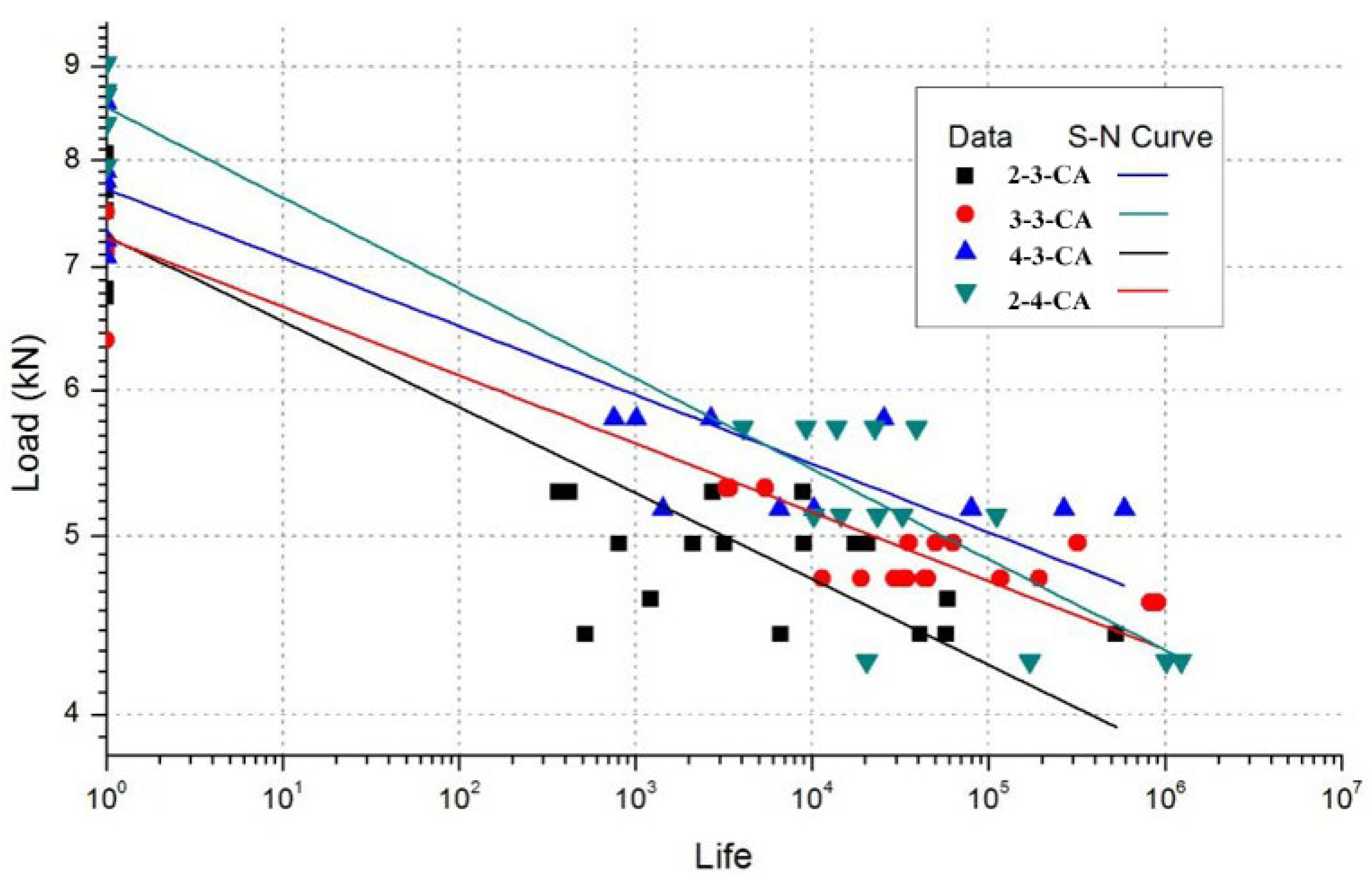



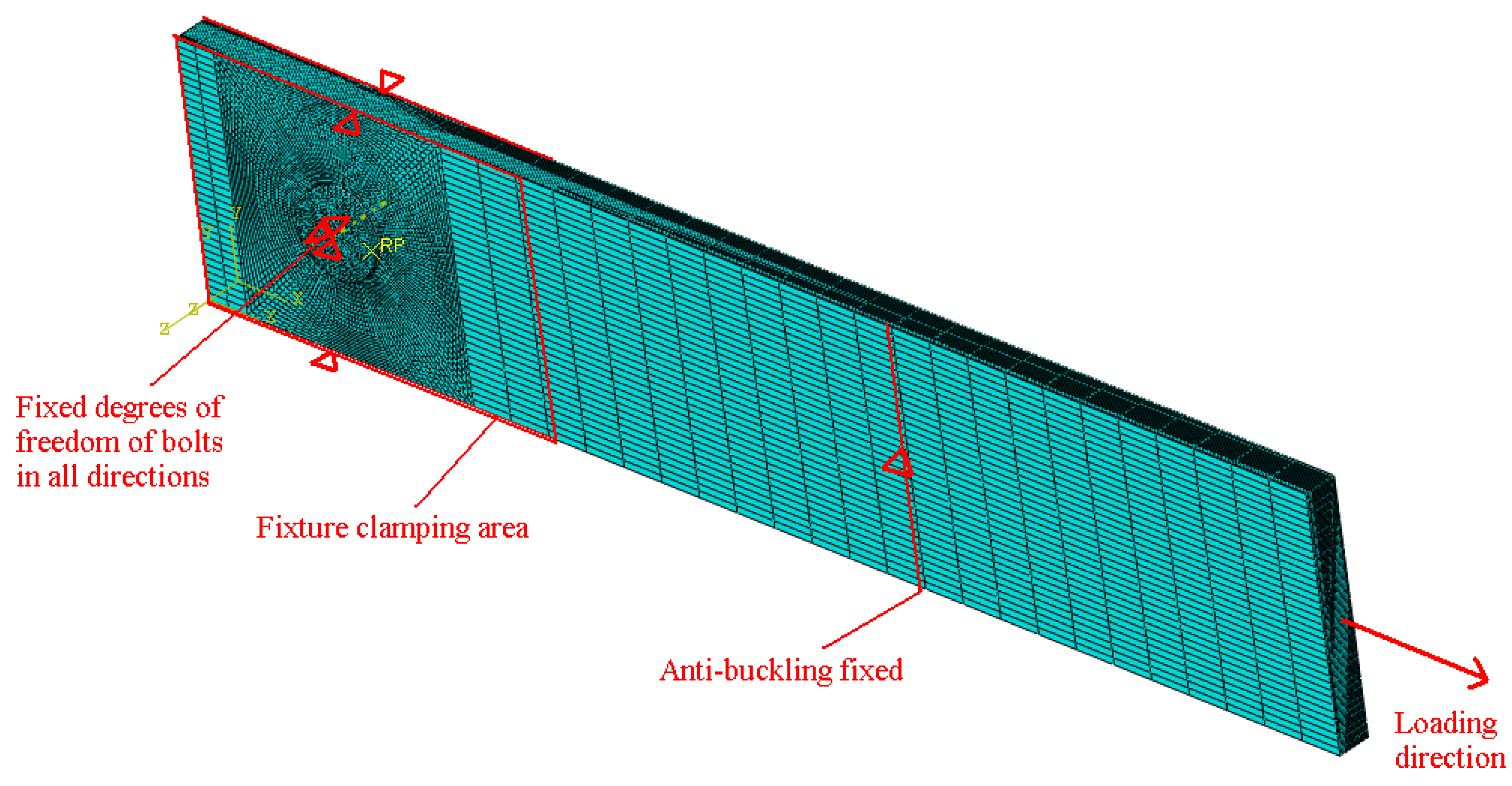
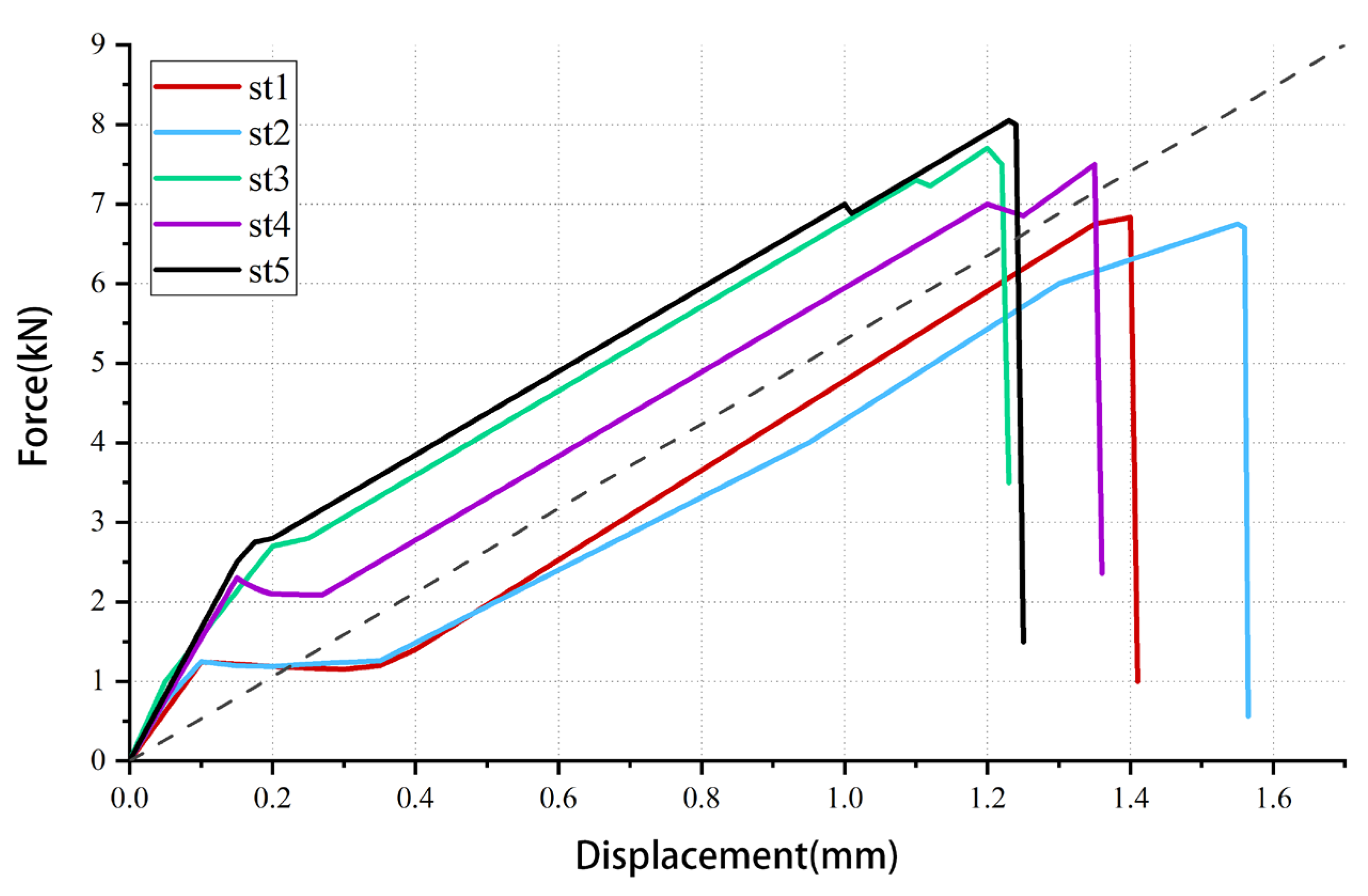

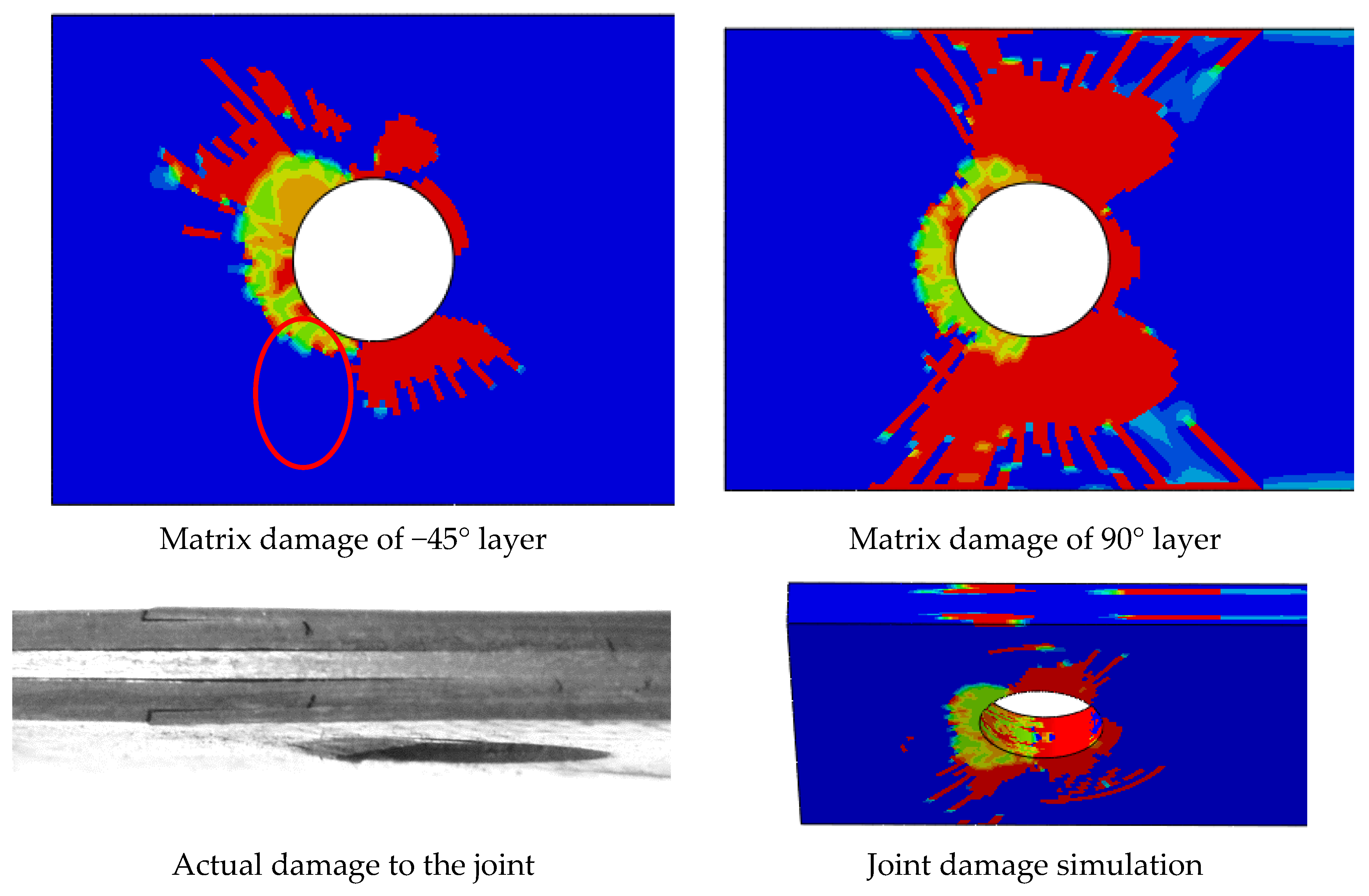
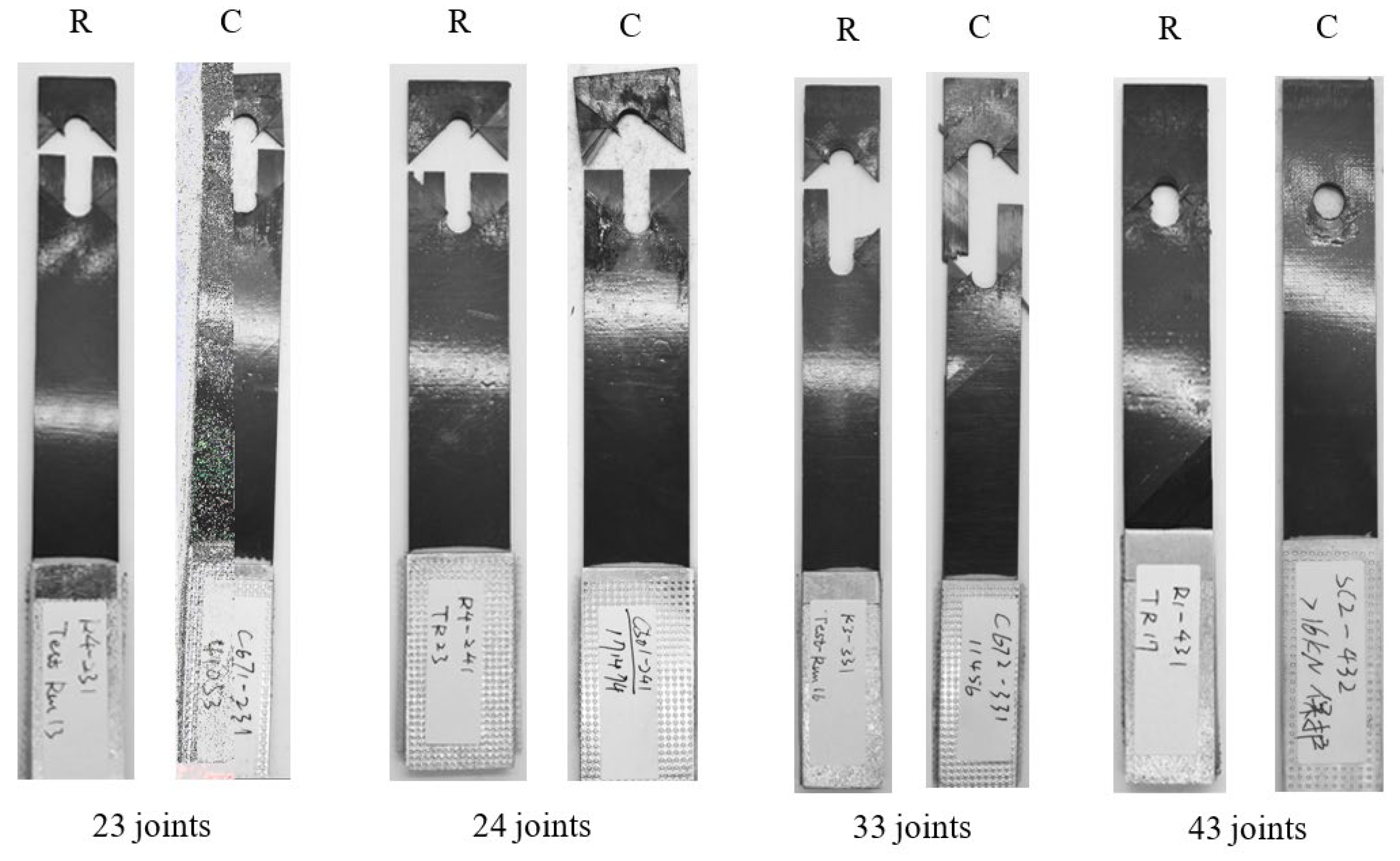
| No. 1 | No. 2 | No. 3 | No. 4 | |
|---|---|---|---|---|
| E/D | 2 | 3 | 4 | 2 |
| W/D | 3 | 3 | 3 | 4 |
| Failure Modes | N | S | B | DE | BK | ||||||
|---|---|---|---|---|---|---|---|---|---|---|---|
| Geometric Parameter Ratios | |||||||||||
| 23 | T | T | C | C | |||||||
| 33 | T | T | C | C | |||||||
| 43 | T | T | C | C | |||||||
| 24 | T | T | C | T | C | C | |||||
| Fitting Parameters | A | b | Standard Error | |
|---|---|---|---|---|
| Geometric Parameters Ratios | ||||
| 2-3-CA | 7.28 | −0.04537 | 0.00256 | |
| 3-3-CA | 7.26 | −0.03725 | 0.00221 | |
| 4-3-CA | 7.72 | −0.03599 | 0.00245 | |
| 2-4-CA | 8.55 | −0.04912 | 0.00203 | |
| Failure Modes | N | S | B | DE | BK | |
|---|---|---|---|---|---|---|
| Geometric Parameters Ratios | ||||||
| 2-3-CA | ◯ | ◯ | ◯ | |||
| 3-3-CA | ◯ | ◯ | ◯ | |||
| 4-3-CA | ◯ | ◯ | ◯ | |||
| 2-4-CA | ◯ | ◯ | ◯ | ◯ | ||
| N | S | B | DE | BK | |
|---|---|---|---|---|---|
| Static Experiment | ◯ | ◯ | ◯ | ◯ | |
| CA | ◯ | ◯ | ◯ | ◯ | ◯ |
| RF | ◯ | ◯ | ◯ |
| GP | Load Level | Average Life (s) | Prediction (s) | Error |
|---|---|---|---|---|
| 2-3-RF | 104% | 38,573.20 | 56,075.56 | 45.4% |
| 2-4-RF | 155% | 45,379.00 | 29,009.72 | 36.1% |
| 3-3-RF | 127% | 21,503.33 | 13,169.73 | 38.8% |
| 4-3-RF | 155% | 38,855.33 | 30,945.35 | 21.4% |
| Properties | E11 | E22 | E33 | G12 | G13 | G23 | S23 |
|---|---|---|---|---|---|---|---|
| Static magnitude | 147.0 GPa | 9.0 GPa | 9.0 GPa | 5.0 GPa | 5.0 GPa | 3.0 GPa | 42 MPa |
| XT | XC | YT | YC | ZT | ZC | S12 | S13 |
| 2004 MPa | 1197 MPa | 53 MPa | 204 MPa | 53 MPa | 204 MPa | 137 MPa | 137 MPa |
| Fatigue Parameters | ||
|---|---|---|
| A | β | |
| E11 | 14.5700 | 0.3024 |
| E22 | 14.7700 | 0.1155 |
| E33 | 14.7700 | 0.1155 |
| G12 | 0.7000 | 11.0000 |
| G13 | 0.7000 | 11.0000 |
| G23 | 0.7000 | 11.0000 |
| XT | 10.0300 | 0.4730 |
| XC | 49.0600 | 0.0250 |
| YT | 9.6280 | 0.1255 |
| YC | 67.3600 | 0.0011 |
| ZT | 9.6280 | 0.1255 |
| ZC | 67.3600 | 0.0011 |
| S12 | 0.1600 | 9.1100 |
| S13 | 0.1600 | 9.1100 |
| S23 | 0.1600 | 9.1100 |
| Failure Modes | |||||||
|---|---|---|---|---|---|---|---|
| FT | FC | F-M S | MT | MC | NT | NC | |
| E11 | 0 | 0 | |||||
| E22 | 0 | 0 | 0 | 0 | |||
| E33 | 0 | 0 | 0 | 0 | |||
| G12 | 0 | 0 | 0 | ||||
| G13 | 0 | 0 | |||||
| G23 | 0 | 0 | |||||
| XT | 0 | 0 | |||||
| XC | 0 | 0 | |||||
| YT | 0 | 0 | 0 | ||||
| YC | 0 | 0 | 0 | ||||
| ZT | 0 | 0 | 0 | ||||
| ZC | 0 | 0 | 0 | ||||
| S12 | 0 | 0 | 0 | ||||
| S13 | 0 | 0 | |||||
| S23 | 0 | 0 | |||||
| Test Fatigue Life (s) | Cumulative Damage Method Prediction (s) | FEA Method Prediction (s) |
|---|---|---|
| 38,573.20 | 56,075.56 | 27,239.18 |
Disclaimer/Publisher’s Note: The statements, opinions and data contained in all publications are solely those of the individual author(s) and contributor(s) and not of MDPI and/or the editor(s). MDPI and/or the editor(s) disclaim responsibility for any injury to people or property resulting from any ideas, methods, instructions or products referred to in the content. |
© 2024 by the authors. Licensee MDPI, Basel, Switzerland. This article is an open access article distributed under the terms and conditions of the Creative Commons Attribution (CC BY) license (https://creativecommons.org/licenses/by/4.0/).
Share and Cite
Zhou, S.; Yang, B.; Huang, Y.; Wu, X. Fatigue Analysis of Composite Bolted Joints under Random and Constant Amplitude Fatigue Loadings. Materials 2024, 17, 2740. https://doi.org/10.3390/ma17112740
Zhou S, Yang B, Huang Y, Wu X. Fatigue Analysis of Composite Bolted Joints under Random and Constant Amplitude Fatigue Loadings. Materials. 2024; 17(11):2740. https://doi.org/10.3390/ma17112740
Chicago/Turabian StyleZhou, Song, Bo Yang, Yichang Huang, and Xiaodi Wu. 2024. "Fatigue Analysis of Composite Bolted Joints under Random and Constant Amplitude Fatigue Loadings" Materials 17, no. 11: 2740. https://doi.org/10.3390/ma17112740





